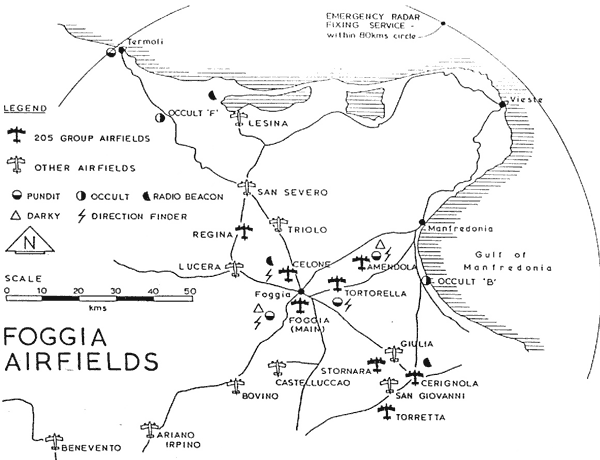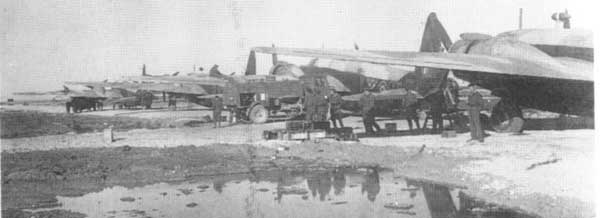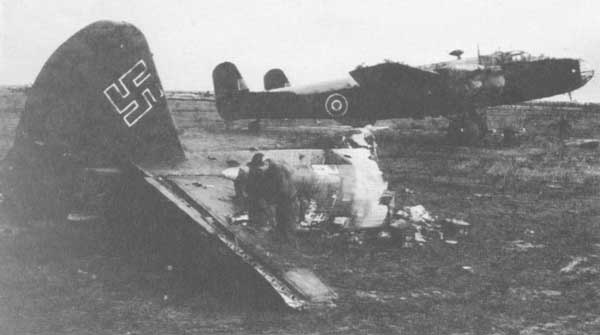AIRFIELD OPERATING CONDITIONS
The Foggia Plain bases shared by 205 group and USAAF squadrons were overcrowded and short of facilities. The slightest rain reduced them to mud which the Italian sun would quickly convert to a fine penetrating dust. These conditions placed considerable strain on aircrews and aircraft and were a constant source of nightmares for the supply staff and ground crews that worked endlessly and against all odds to keep their squadrons operational.

Wing Commander Dick Banker described the airfield at Tortorella:
"All except Foggia Main started out as single-strip airfields: running about north-south and made by US Army Engineers out of well rolled local soft rock with pierced steel planking (PSP) on top. They were raised up about nine inches above the surrounding ground to keep them above water level in winter. At Tortorella the B-17 Fortresses of 99 BG were encamped on one side of the strip and our Wellingtons on the other.
"USAAF ground crews began their daily inspections at about 0300 hours. It appeared to consist of belting up all four engines in every aircraft. About an hour later the aircrews came out and did the same and then they took off. Somewhere about this time, our night bomber force landed and taxied in. By about midday something like peace descended on the airfields, apart from an occasional air test. Then the Americans would land and taxi in and at about dusk 205 groups aircraft would warm up and take off and the whole cycle repeated itself again. All this on unpaved black cotton-soil and throughout the summer we lived in a permanent dust haze. No wonder it was known as ‘Filthy Foggia’".

Re-fueling and maintenance of Wellingtons on the
taxiway at Cerignola in early 1944.
Len Fieldhouse recalled some of the confusion of night flying from these airfields:
"...the only control at take-off was an Aldis lamp flashed by a sergeant housed in a caravan at the end of the runway. During an operation various coded messages were sent out by radio and consisted usually of TOT (time over target) and ETA (estimated time of arrival). Recalls were passed in this way. To assist in bad weather, the Army would put up a number of searchlight beams in a cone over our radio beacon. These could be seen through cloud. Landing instructions were passed by radio only when the aircraft was actually in the circuit. At times all the squadrons would arrive back at once and begin milling about the area, the circuits of some airfields being ‘opposed’ to those of their neighbors. I saw two aircraft go down in flames and I, myself, missed another Wellington by feet while in a circuit. Of course, no navigation lights were shown - the enemy was not much more than 100 miles away. The take-offs of the various squadrons were at staggered times and it was hoped that they would not all arrive back together, but this was more of a pious hope! Even in daylight, control tended to be a bit rough and ready. My first arrival at Foggia coincided with the return of B-17’s from a raid. I had permission to land from the American Air Traffic Controller and was on finals when I was literally elbowed out of the way by a stream of Fortresses landing on the parallel runway. "
There were some aids to navigation and the system improved during the summer as the land battle developed. "Occult" beacons flashed a single morse letter in white light from sunset to sunrise daily. There were two in the Foggia area, "B-Baker" on the coast north of Cerignola and "F-Fox" inland south-east of Termoli. Len Fieldhouse remembered:
"...the ‘Chance Light’ which was a powerful white-light beam powered by a mobile generator and producing several million candlepower. It was positioned at the end of the runway to assist night landings and only used sparingly, as it could be seen for miles. Usually a pilot had to request it and it would only be switched on just before his touch-down to shine ahead of him down the runway. The ‘Pundit’ was a mobile lamp system flashing two code letters in morse in red. They were placed some distance from the airfield at a bearing and distance from it notified to the crews before take off. In clear conditions it could be seen for 50 miles.
"Four ‘Pundits’ were available, based one each at Amendola, Tortorella, Foggia Main and Termoli.
"‘Darky’ was a radio service to give bearings and positions to lost aircraft. It had a very limited range. The drill was that a pilot, on discovering that he was lost, would call, ‘Darky - Darky’ on his radio and leave the set on transmit for a brief time. At least three ground stations would triangulate on his position from this transmitted signal and pass it on to the pilot. Sounds simple but in practice it had only short range and was subject to interference. Incredibly, old hands never flew directly over these and other navigational aids because of congestion and the risk of lurking enemy fighters. "
Allied Fighters could also pose a problem. On arrival at Foggia, No. 70 Squadron’s Wellingtons were parked on either side of the landing strip awaiting dispersal. John Bodman recounted how:
"...a trio of P-51 Mustangs came in to land in formation and one of them ran straight into a Wellington, slicing it neatly in half. The pilot stepped out of the wreckage and remarked, "I guess I just didn’t see it!’ "

A wrecked Ju-88 tail assembly makes a useful
workbench for servicing crews of 614 Squadron at Celone.
A Halifax MK II Series 1A of 614 Squadron stands in the background.
Another Foggia experience recalled by Tom Parker regarding a common problem of Wellington tires:
"We had no less than three tire checks between dispersal and the head of the runway - all done with an ordinary flashlight. On one occaision a Wellington taking off had a tire burst. The undercarriage collapsed and friction and sparks caused the dope-soaked canvas skin to ignite. ‘Abandon aircraft’ was ordered and we all scampered to the slit trenches alongside the perimeter track while the aircraft, which were nose to tail, blew up one after the other. I witnessed the greatest display of pyrotechnics ever as we were pinned down while bomb loads, photo flashes, flares, fuel tanks and ammo were exploding in all directions. So a lack of supplies on this mission caused more damage and havoc than all the enemy flak and night fighters could have done."
Derek Cashmore of 70 Squadron remembered that the main PSP runway at Tortorella was 2000 yards long and that there was a wide dirt ‘runway’ running parallel for ‘belly’ landings. On arrival over the airfield:
"...you flew along the runway and flashed your recognition letter to the ground. If that was acknowledged a green light was flashed back and we would go round and come in to land. If a red light was flashed back you went round again and repeated the process. "
Don Twigg of 70 Squadron told of the bad luck of his colleague, Bob Custance, operating out of Tortorella:
"...he hit the railway embankment at the end of the runway on landing one night. On another, he blew a tire on take off and ran over a fire tender. They all got out and ran away before it all blew up. One night, over Budapest, Bob collided with another aircraft and, although ten feet of port wing was chopped off, he limped home and landed safely. He was cited for his courage and airmanship. He was killed on the 6/7 July raid over Feuersbrunn. "
Crash on Take-off - "Ploughing"
When we flew across to Italy the weather behaved bitterly
And we hadn’t got a single truck or tent.
So we commandeered a farm, without the slightest qualm,
When we heard the owner was a fascist gent.
Where the field had once been ploughed the Yankees did us proud
By carving out for us an instant strip.
But when we had some rain, back it went to plough again,
And our undercarriage wheels began to slip
We operated nightly but it got a bit unsightly
With the mudbound wrecks on each side of the run.
Taking off between the hulls, and the wheeling clouds of gulls,
Loaded up with bombs and petrol wasn’t fun.
Standing in the wooden tower, feeling drunk with power,
I was Officer in Charge of Ops one night
When a Wimpy opened wide, hit the mud along the side,
Collapsed his undercart and veered off right.
I thought it for the best when the aircraft came to rest
On our line with only fifty yards to spare.
We’d begun to breathe again, when from underneath the plane,
A great two-ton bomb came bouncing through the air.
Some fell flat upon the floor, others stuck right in the door,
To get the hell away the common aim.
The human logjam on the ladder, simply couldn’t have been gladder,
When the almighty explosion never came.
The bomb stuck in a rut a few feet from our hut
And it seemed as if the safety fuse held good.
But when we gave it close inspection, our ideas needed correction.
It was held safe by a small piece of wood.
-- Len Fieldhouse, Foggia Plain
According to Bill Burcham, the Americans would evacuate their quarters when the Wellingtons took off after one had crashed on take off and exploded at the end of the runway.

A crashed German Ju-88 fighter on the airfield at Amendola

